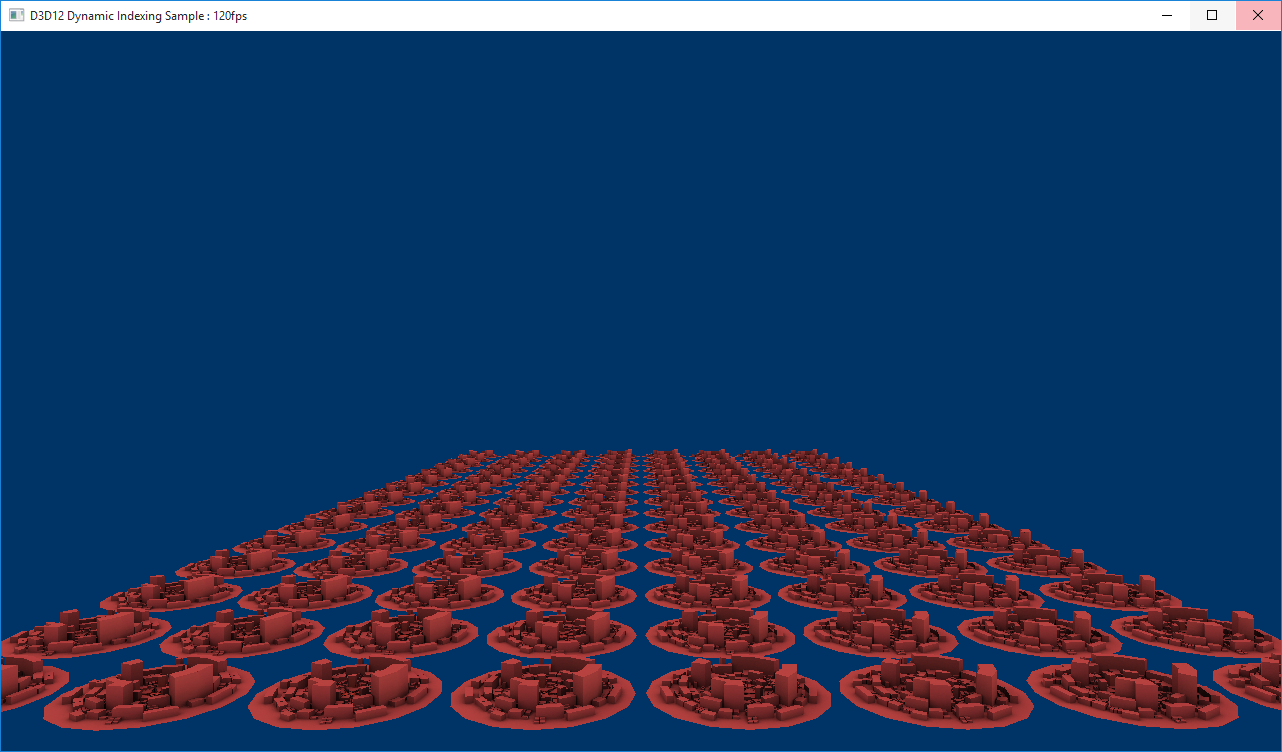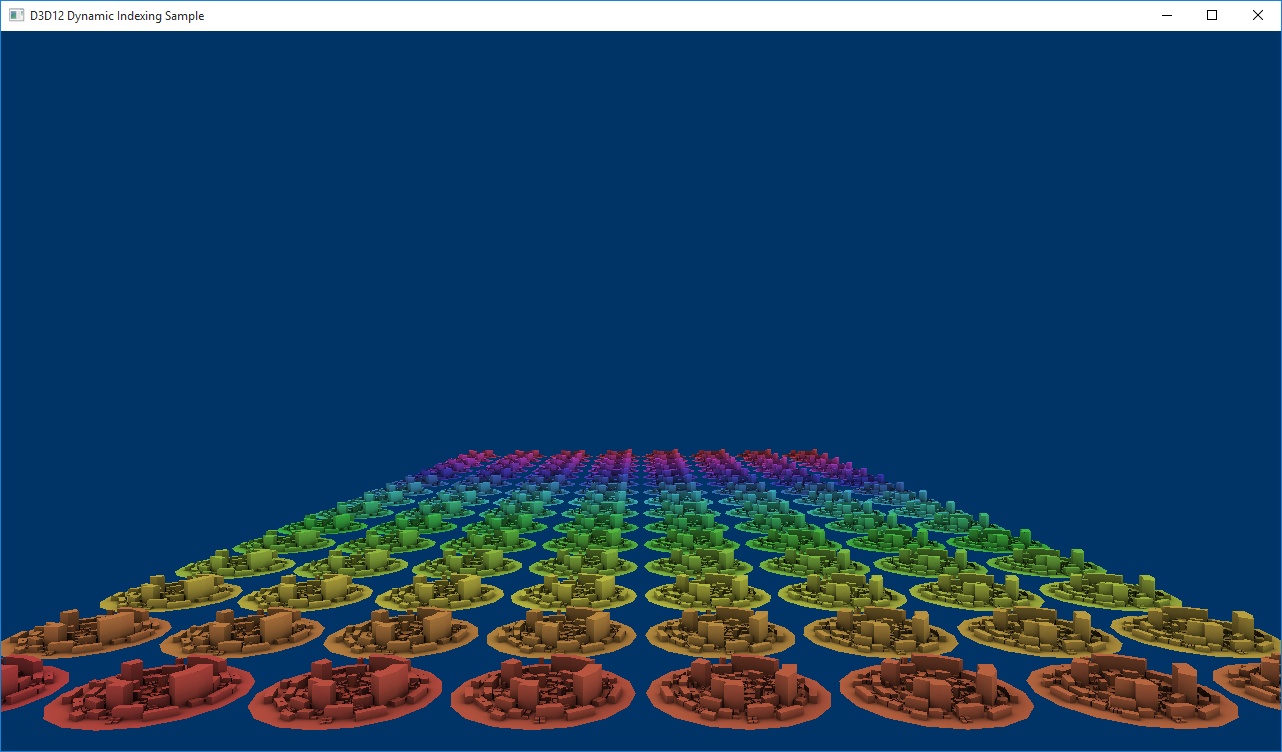Indexation dynamique à l’aide de HLSL 5.1
L’exemple D3D12DynamicIndexing illustre certaines des nouvelles fonctionnalités HLSL disponibles dans le modèle nuanceur 5.1 (en particulier l’indexation dynamique et les tableaux non délimités) pour afficher le même maillage plusieurs fois, le rendant à chaque fois avec un matériau sélectionné dynamiquement. Avec l’indexation dynamique, les nuanceurs peuvent désormais indexer dans un tableau sans connaître la valeur de l’index au moment de la compilation. Lorsqu’elle est combinée à des tableaux non délimités, cela ajoute un autre niveau d’indirection et de flexibilité pour les auteurs de nuanceurs et les pipelines d’art.
- Configurer le nuanceur de pixels
- Configurer la signature racine
- Créer les textures
- Charger les données de texture
- Charger la texture diffuse
- Créer un échantillonneur
- Modifier dynamiquement l’index de paramètre racine
- Exécuter l’exemple
- Rubriques connexes
Configurer le nuanceur de pixels
Examinons d’abord le nuanceur lui-même, qui pour cet exemple est un nuanceur de pixels.
Texture2D g_txDiffuse : register(t0);
Texture2D g_txMats[] : register(t1);
SamplerState g_sampler : register(s0);
struct PSSceneIn
{
float4 pos : SV_Position;
float2 tex : TEXCOORD0;
};
struct MaterialConstants
{
uint matIndex; // Dynamically set index for looking up from g_txMats[].
};
ConstantBuffer<MaterialConstants> materialConstants : register(b0, space0);
float4 PSSceneMain(PSSceneIn input) : SV_Target
{
float3 diffuse = g_txDiffuse.Sample(g_sampler, input.tex).rgb;
float3 mat = g_txMats[materialConstants.matIndex].Sample(g_sampler, input.tex).rgb;
return float4(diffuse * mat, 1.0f);
}
La fonctionnalité de tableau sans limite est illustrée par le g_txMats[] tableau, car il ne spécifie pas de taille de tableau. L’indexation dynamique est utilisée pour indexer dans g_txMats[] avec matIndex, qui est défini comme une constante racine. Le nuanceur n’a aucune connaissance de la taille, du tableau ou de la valeur de l’index au moment de la compilation. Les deux attributs sont définis dans la signature racine de l’objet d’état du pipeline utilisé avec le nuanceur.
Pour tirer parti des fonctionnalités d’indexation dynamique dans HLSL, le nuanceur doit être compilé avec SM 5.1. En outre, pour utiliser des tableaux non délimités, l’indicateur /enable_unbounded_descriptor_tables doit également être utilisé. Les options de ligne de commande suivantes sont utilisées pour compiler ce nuanceur avec l’outil Effect-Compiler Tool (FXC) :
fxc /Zi /E"PSSceneMain" /Od /Fo"dynamic_indexing_pixel.cso" /ps"_5_1" /nologo /enable_unbounded_descriptor_tables
Configurer la signature racine
Examinons maintenant la définition de signature racine, en particulier la façon dont nous définissons la taille du tableau indépendant et liez une constante racine à matIndex. Pour le nuanceur de pixels, nous définissons trois éléments : une table de descripteur pour les SDR (nos Texture2D), une table de descripteur pour les échantillonneurs et une seule constante racine. La table de descripteur pour nos SRV contient CityMaterialCount + 1 des entrées.
CityMaterialCount est une constante qui définit la longueur de g_txMats[] et le + 1 est pour g_txDiffuse. La table de descripteur pour nos samplers ne contient qu’une seule entrée et nous définissons une seule valeur de constante racine 32 bits via InitAsConstants (...), dans la méthode LoadAssets .
// Create the root signature.
{
CD3DX12_DESCRIPTOR_RANGE ranges[3];
ranges[0].Init(D3D12_DESCRIPTOR_RANGE_TYPE_SRV, 1 + CityMaterialCount, 0); // Diffuse texture + array of materials.
ranges[1].Init(D3D12_DESCRIPTOR_RANGE_TYPE_SAMPLER, 1, 0);
ranges[2].Init(D3D12_DESCRIPTOR_RANGE_TYPE_CBV, 1, 0);
CD3DX12_ROOT_PARAMETER rootParameters[4];
rootParameters[0].InitAsDescriptorTable(1, &ranges[0], D3D12_SHADER_VISIBILITY_PIXEL);
rootParameters[1].InitAsDescriptorTable(1, &ranges[1], D3D12_SHADER_VISIBILITY_PIXEL);
rootParameters[2].InitAsDescriptorTable(1, &ranges[2], D3D12_SHADER_VISIBILITY_VERTEX);
rootParameters[3].InitAsConstants(1, 0, 0, D3D12_SHADER_VISIBILITY_PIXEL);
CD3DX12_ROOT_SIGNATURE_DESC rootSignatureDesc;
rootSignatureDesc.Init(_countof(rootParameters), rootParameters, 0, nullptr, D3D12_ROOT_SIGNATURE_FLAG_ALLOW_INPUT_ASSEMBLER_INPUT_LAYOUT);
ComPtr<ID3DBlob> signature;
ComPtr<ID3DBlob> error;
ThrowIfFailed(D3D12SerializeRootSignature(&rootSignatureDesc, D3D_ROOT_SIGNATURE_VERSION_1, &signature, &error));
ThrowIfFailed(m_device->CreateRootSignature(0, signature->GetBufferPointer(), signature->GetBufferSize(), IID_PPV_ARGS(&m_rootSignature)));
}
Créer les textures
Le contenu de sont des g_txMats[] textures générées de manière procédurale créées dans LoadAssets. Chaque ville rendue dans la scène partage la même texture diffuse, mais chacune a également sa propre texture générée de manière procédurale. Le tableau de textures s’étend sur le spectre de l’arc-en-ciel pour visualiser facilement la technique d’indexation.
// Create the textures and sampler.
{
// Procedurally generate an array of textures to use as city materials.
{
// All of these materials use the same texture desc.
D3D12_RESOURCE_DESC textureDesc = {};
textureDesc.MipLevels = 1;
textureDesc.Format = DXGI_FORMAT_R8G8B8A8_UNORM;
textureDesc.Width = CityMaterialTextureWidth;
textureDesc.Height = CityMaterialTextureHeight;
textureDesc.Flags = D3D12_RESOURCE_FLAG_NONE;
textureDesc.DepthOrArraySize = 1;
textureDesc.SampleDesc.Count = 1;
textureDesc.SampleDesc.Quality = 0;
textureDesc.Dimension = D3D12_RESOURCE_DIMENSION_TEXTURE2D;
// The textures evenly span the color rainbow so that each city gets
// a different material.
float materialGradStep = (1.0f / static_cast<float>(CityMaterialCount));
// Generate texture data.
vector<vector<unsigned char>> cityTextureData;
cityTextureData.resize(CityMaterialCount);
for (int i = 0; i < CityMaterialCount; ++i)
{
CD3DX12_HEAP_PROPERTIES heapProps(D3D12_HEAP_TYPE_DEFAULT);
ThrowIfFailed(m_device->CreateCommittedResource(
&heapProps,
D3D12_HEAP_FLAG_NONE,
&textureDesc,
D3D12_RESOURCE_STATE_COPY_DEST,
nullptr,
IID_PPV_ARGS(&m_cityMaterialTextures[i])));
// Fill the texture.
float t = i * materialGradStep;
cityTextureData[i].resize(CityMaterialTextureWidth * CityMaterialTextureHeight * CityMaterialTextureChannelCount);
for (int x = 0; x < CityMaterialTextureWidth; ++x)
{
for (int y = 0; y < CityMaterialTextureHeight; ++y)
{
// Compute the appropriate index into the buffer based on the x/y coordinates.
int pixelIndex = (y * CityMaterialTextureChannelCount * CityMaterialTextureWidth) + (x * CityMaterialTextureChannelCount);
// Determine this row's position along the rainbow gradient.
float tPrime = t + ((static_cast<float>(y) / static_cast<float>(CityMaterialTextureHeight)) * materialGradStep);
// Compute the RGB value for this position along the rainbow
// and pack the pixel value.
XMVECTOR hsl = XMVectorSet(tPrime, 0.5f, 0.5f, 1.0f);
XMVECTOR rgb = XMColorHSLToRGB(hsl);
cityTextureData[i][pixelIndex + 0] = static_cast<unsigned char>((255 * XMVectorGetX(rgb)));
cityTextureData[i][pixelIndex + 1] = static_cast<unsigned char>((255 * XMVectorGetY(rgb)));
cityTextureData[i][pixelIndex + 2] = static_cast<unsigned char>((255 * XMVectorGetZ(rgb)));
cityTextureData[i][pixelIndex + 3] = 255;
}
}
}
}
| Flux des appels | Paramètres |
|---|---|
| D3D12_RESOURCE_DESC |
D3D12_RESOURCE_FLAGS [D3D12_RESOURCE_DIMENSION] (/windows/desktop/api/d3d12/ne-d3d12-d3d12_resource_dimension) |
| CreateCommittedResource |
D3D12_HEAP_TYPE [D3D12_HEAP_FLAG] (/windows/desktop/api/d3d12/ne-d3d12-d3d12_heap_flags) CD3DX12_RESOURCE_DESC [D3D12_RESOURCE_STATES] (/windows/desktop/api/d3d12/ne-d3d12-d3d12_resource_states) |
| XMVECTOR |
[XMColorHSLToRGB] (/windows/desktop/api/directxmath/nf-directxmath-xmcolorhsltorgb) |
Charger les données de texture
Les données de texture sont chargées vers le GPU par le biais d’un tas de chargement et les SMV sont créés pour chacun d’eux et stockés dans un tas de descripteur SRV.
// Upload texture data to the default heap resources.
{
const UINT subresourceCount = textureDesc.DepthOrArraySize * textureDesc.MipLevels;
const UINT64 uploadBufferStep = GetRequiredIntermediateSize(m_cityMaterialTextures[0].Get(), 0, subresourceCount); // All of our textures are the same size in this case.
const UINT64 uploadBufferSize = uploadBufferStep * CityMaterialCount;
CD3DX12_HEAP_PROPERTIES uploadHeap(D3D12_HEAP_TYPE_UPLOAD);
auto uploadDesc = CD3DX12_RESOURCE_DESC::Buffer(uploadBufferSize);
ThrowIfFailed(m_device->CreateCommittedResource(
&uploadHeap,
D3D12_HEAP_FLAG_NONE,
&uploadDesc,
D3D12_RESOURCE_STATE_GENERIC_READ,
nullptr,
IID_PPV_ARGS(&materialsUploadHeap)));
for (int i = 0; i < CityMaterialCount; ++i)
{
// Copy data to the intermediate upload heap and then schedule
// a copy from the upload heap to the appropriate texture.
D3D12_SUBRESOURCE_DATA textureData = {};
textureData.pData = &cityTextureData[i][0];
textureData.RowPitch = static_cast<LONG_PTR>((CityMaterialTextureChannelCount * textureDesc.Width));
textureData.SlicePitch = textureData.RowPitch * textureDesc.Height;
UpdateSubresources(m_commandList.Get(), m_cityMaterialTextures[i].Get(), materialsUploadHeap.Get(), i * uploadBufferStep, 0, subresourceCount, &textureData);
auto barrier = CD3DX12_RESOURCE_BARRIER::Transition(m_cityMaterialTextures[i].Get(), D3D12_RESOURCE_STATE_COPY_DEST, D3D12_RESOURCE_STATE_PIXEL_SHADER_RESOURCE);
m_commandList->ResourceBarrier(1, &barrier);
}
}
| Flux des appels | Paramètres |
|---|---|
| GetRequiredIntermediateSize | |
| CreateCommittedResource | |
| D3D12_SUBRESOURCE_DATA | |
| UpdateSubresources | |
| ResourceBarrier |
Charger la texture diffuse
La texture diffuse, g_txDiffuse, est chargée de la même manière et obtient également son propre SRV, mais les données de texture sont déjà définies dans occcity.bin.
// Load the occcity diffuse texture with baked-in ambient lighting.
// This texture will be blended with a texture from the materials
// array in the pixel shader.
{
D3D12_RESOURCE_DESC textureDesc = {};
textureDesc.MipLevels = SampleAssets::Textures[0].MipLevels;
textureDesc.Format = SampleAssets::Textures[0].Format;
textureDesc.Width = SampleAssets::Textures[0].Width;
textureDesc.Height = SampleAssets::Textures[0].Height;
textureDesc.Flags = D3D12_RESOURCE_FLAG_NONE;
textureDesc.DepthOrArraySize = 1;
textureDesc.SampleDesc.Count = 1;
textureDesc.SampleDesc.Quality = 0;
textureDesc.Dimension = D3D12_RESOURCE_DIMENSION_TEXTURE2D;
CD3DX12_HEAP_PROPERTIES heapProps(D3D12_HEAP_TYPE_DEFAULT);
ThrowIfFailed(m_device->CreateCommittedResource(
&heapProps,
D3D12_HEAP_FLAG_NONE,
&textureDesc,
D3D12_RESOURCE_STATE_COPY_DEST,
nullptr,
IID_PPV_ARGS(&m_cityDiffuseTexture)));
const UINT subresourceCount = textureDesc.DepthOrArraySize * textureDesc.MipLevels;
const UINT64 uploadBufferSize = GetRequiredIntermediateSize(m_cityDiffuseTexture.Get(), 0, subresourceCount);
CD3DX12_HEAP_PROPERTIES uploadHeap(D3D12_HEAP_TYPE_UPLOAD);
auto uploadDesc = CD3DX12_RESOURCE_DESC::Buffer(uploadBufferSize);
ThrowIfFailed(m_device->CreateCommittedResource(
&uploadHeap,
D3D12_HEAP_FLAG_NONE,
&uploadDesc,
D3D12_RESOURCE_STATE_GENERIC_READ,
nullptr,
IID_PPV_ARGS(&textureUploadHeap)));
// Copy data to the intermediate upload heap and then schedule
// a copy from the upload heap to the diffuse texture.
D3D12_SUBRESOURCE_DATA textureData = {};
textureData.pData = pMeshData + SampleAssets::Textures[0].Data[0].Offset;
textureData.RowPitch = SampleAssets::Textures[0].Data[0].Pitch;
textureData.SlicePitch = SampleAssets::Textures[0].Data[0].Size;
UpdateSubresources(m_commandList.Get(), m_cityDiffuseTexture.Get(), textureUploadHeap.Get(), 0, 0, subresourceCount, &textureData);
auto barrier = CD3DX12_RESOURCE_BARRIER::Transition(m_cityDiffuseTexture.Get(), D3D12_RESOURCE_STATE_COPY_DEST, D3D12_RESOURCE_STATE_PIXEL_SHADER_RESOURCE);
m_commandList->ResourceBarrier(1, &barrier);
}
| Flux des appels | Paramètres |
|---|---|
| D3D12_RESOURCE_DESC | |
| CreateCommittedResource | |
| GetRequiredIntermediateSize | |
| CreateCommittedResource | |
| D3D12_SUBRESOURCE_DATA | |
| ResourceBarrier |
Créer un échantillonneur
Enfin, pour LoadAssets, un échantillonneur unique est créé pour échantillonner à partir de la texture diffuse ou du tableau de textures.
// Describe and create a sampler.
D3D12_SAMPLER_DESC samplerDesc = {};
samplerDesc.Filter = D3D12_FILTER_MIN_MAG_MIP_LINEAR;
samplerDesc.AddressU = D3D12_TEXTURE_ADDRESS_MODE_WRAP;
samplerDesc.AddressV = D3D12_TEXTURE_ADDRESS_MODE_WRAP;
samplerDesc.AddressW = D3D12_TEXTURE_ADDRESS_MODE_WRAP;
samplerDesc.MinLOD = 0;
samplerDesc.MaxLOD = D3D12_FLOAT32_MAX;
samplerDesc.MipLODBias = 0.0f;
samplerDesc.MaxAnisotropy = 1;
samplerDesc.ComparisonFunc = D3D12_COMPARISON_FUNC_ALWAYS;
m_device->CreateSampler(&samplerDesc, m_samplerHeap->GetCPUDescriptorHandleForHeapStart());
// Create SRV for the city's diffuse texture.
CD3DX12_CPU_DESCRIPTOR_HANDLE srvHandle(m_cbvSrvHeap->GetCPUDescriptorHandleForHeapStart(), 0, m_cbvSrvDescriptorSize);
D3D12_SHADER_RESOURCE_VIEW_DESC diffuseSrvDesc = {};
diffuseSrvDesc.Shader4ComponentMapping = D3D12_DEFAULT_SHADER_4_COMPONENT_MAPPING;
diffuseSrvDesc.Format = SampleAssets::Textures->Format;
diffuseSrvDesc.ViewDimension = D3D12_SRV_DIMENSION_TEXTURE2D;
diffuseSrvDesc.Texture2D.MipLevels = 1;
m_device->CreateShaderResourceView(m_cityDiffuseTexture.Get(), &diffuseSrvDesc, srvHandle);
srvHandle.Offset(m_cbvSrvDescriptorSize);
// Create SRVs for each city material.
for (int i = 0; i < CityMaterialCount; ++i)
{
D3D12_SHADER_RESOURCE_VIEW_DESC materialSrvDesc = {};
materialSrvDesc.Shader4ComponentMapping = D3D12_DEFAULT_SHADER_4_COMPONENT_MAPPING;
materialSrvDesc.Format = DXGI_FORMAT_R8G8B8A8_UNORM;
materialSrvDesc.ViewDimension = D3D12_SRV_DIMENSION_TEXTURE2D;
materialSrvDesc.Texture2D.MipLevels = 1;
m_device->CreateShaderResourceView(m_cityMaterialTextures[i].Get(), &materialSrvDesc, srvHandle);
srvHandle.Offset(m_cbvSrvDescriptorSize);
}
Modifier dynamiquement l’index de paramètre racine
Si nous devions restituer la scène maintenant, toutes les villes apparaîtraient comme les mêmes, car nous n’avons pas défini la valeur de notre constante racine, matIndex. Chaque nuanceur de pixels s’indexe dans le 0e emplacement de g_txMats et la scène se présente comme suit :

La valeur de la constante racine est définie dans FrameResource::P opulateCommandLists. Dans la boucle double for où une commande draw est enregistrée pour chaque ville, nous enregistrons un appel à SetGraphicsRoot32BitConstants en spécifiant notre index de paramètre racine en ce qui concerne la signature racine (dans le cas présent 3) la valeur de l’index dynamique et un décalage dans ce cas 0. Étant donné que la longueur de g_txMats est égale au nombre de villes que nous rendons, la valeur de l’index est définie de manière incrémentielle pour chaque ville.
for (UINT i = 0; i < m_cityRowCount; i++)
{
for (UINT j = 0; j < m_cityColumnCount; j++)
{
pCommandList->SetPipelineState(pPso);
// Set the city's root constant for dynamically indexing into the material array.
pCommandList->SetGraphicsRoot32BitConstant(3, (i * m_cityColumnCount) + j, 0);
// Set this city's CBV table and move to the next descriptor.
pCommandList->SetGraphicsRootDescriptorTable(2, cbvSrvHandle);
cbvSrvHandle.Offset(cbvSrvDescriptorSize);
pCommandList->DrawIndexedInstanced(numIndices, 1, 0, 0, 0);
}
}
| Flux des appels | Paramètres |
|---|---|
| SetPipelineState | |
| SetGraphicsRoot32BitConstant | |
| SetGraphicsRootDescriptorTable | |
| DrawIndexedInstanced |
Exécution de l'exemple
À présent, lorsque nous restituons la scène, chaque ville a une valeur différente pour matIndex et recherche donc une texture différente de g_txMats[] la scène comme suit :
